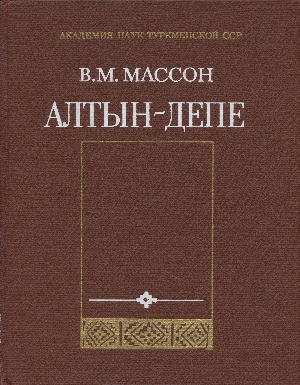 В.М. Массон
В.М. Массон
Алтын-Депе.
[ аннотация: ]
Книга посвящена итогам 15-летних раскопок ЮТАКЭ на поселении Алтын-Депе, в результате которых на территории СССР был открыт северный очаг цивилизаций древневосточного типа. Анализируются результаты раскопок жилых кварталов, описываются предметы материальной культуры, определяются хронология памятника и его историко-культурные связи. Особенно важны многочисленные свидетельства торговых связей с древней цивилизацией долины Инда. Рассматриваются проблемы формирования поселений городского типа на Древнем Востоке.
Издание рассчитано на специалистов: археологов, историков и этнографов.
Оглавление
Введение. — 5
Глава первая. Алтын-Депе в эпохи энеолита и ранней бронзы. — 10
Глава вторая. Раскопки оборонительных сооружений. — 30
Глава третья. Раскопки жилых кварталов. — 35
Глава четвёртая. Изучение культового центра. — 56
Глава пятая. Алтын-Депе как археологический комплекс, вопросы типологии и хронологии. — 81
Глава шестая. Алтын-Депе как поселение городского типа, опыт структурно-функциональной характеристики. — 96
Глава седьмая. Алтын-Депе в культурной системе Древнего Востока. — 109
Глава восьмая. Раннегородские центры и древние цивилизации. — 119
Заключение. — 129
Таблицы I-XXXIV. — 137-165
Литература. — 166
Список сокращений. — 173
Summary. ^
Altin-Depe represents a settlement of an urban type which belongs to the last quarter of the III — beginning of the II millenium b.c. The initial settlement appeared here in the eneolithic period in the V millenium b.c., when pottery of Namazga I was spread into this area (tab. XXIV). The economy of the local population was based on irrigation agriculture and herding of domestic animals. Later, a sequential development of cultures occured (fig. 3) and by end of IV millenium b.c., Altin-Depe forms as large center. The culture of this time is characterised by painted pottery of Geoksyur style (tab. IV, XXV) and elegant female figurines (tab. XXVI). The wealth of the burials (tab. XXVII) indicates the beginning of propriety differentiation. These cultural traditions develop in the middle of III millenium b.c., when there is a gradual change of ceramics made on the potter’s wheel with simplified painting (tab. V). At that time, a cult center with surrounding walls (fig. 7, 8), and small sanctuaries and temples (tab. I) was built. By the end of this period, monumental gates were also constructed (fig. 11). All this indicates technological progress and the occurence of structural changes at Altin-Depe which gradually transforms into a settlement of an urban type.
Structural changes are particulary evident in the period of higest urban development at Altin-Depe (fig. 1). At this time a large craftsmen’s quarter is isolated. A cult center is organised in a new place and develops as a monumental complex (fig. 18). Judging by types of dwellings and the character of finds in tombs and graves which are situated near the dwellings (fig. 16; tab. XXVIII), one can distinguish three groups of inhabitants. The higest social group occupies a separate section, «an elite quarter», (fig. 15). The cult center included, as well, a priest’s tomb (fig. 20-23), where various decorations and cult objects were found (tab. XIX-XXII). including gold heads of a wolf and a bull (tab. XXIII). The economy of this period is characterised by the flourishing of crafts which were separated from agriculture. Ceramics were produced on the fast pottery’s wheel (tab. VI, XXXI-XXXIV). Tools and ornaments were produced from arsenic bronze and silver (tab. XIV, XV). Wheeled carts drawn by camels served as transport (tab. XIX, 1; XXX), the horse was not yet known. There is a wide distribution of seals (tab. XVI, XVII) and of female figurines in a flat abstract style different from that of the eneolithic period (tab. VIII-XII). Frequently there are signs on the shoulders of female figurines which are analogous to scripts of the Ancient Near East (fig. 24). A seal with an inscription of a Proto-Indian type was found in the «elite quarter» (tab. XXII, 1a). The level of economic development, social differentiation expressed in the dwelling types and in the grave complexes, and the development of monumental architecture permit us to conclude that we have here an emerging civilisation, the most ancient discovered on the territory of the Soviet Union.
The civilisation of Altin-Depe was a part of the cultural world of the Ancient Near East. It was in close contact with the civilisations in Mesopotamia and in Ancient India, and used standarts and models elaborated there. This is particularly evident in the architecture of the cult complex with a stepped tower of ziggurat type. It is reasonable to suggest that the inhabitans of Altin-Depe, just as those of the Harappan civilisation, spoke in languages of the Proto-Dravidian group. This probably accounts for the appearance in South Turkmenistan of inscription of a Harrapan type. The irrigation agriculture of Altin-Depe belongs to a subtype, which is associated with limited water resources. This situation is similar to the civilisations in Asia Minor and Eastern Mediterranean and in contrast to the civilisations of the great river valley (fig. 33).
In the begining of the II millenium b.c., the site of Altin-Depe is gradually abandoned. The inhabitants are partly resettled to the east in the Murghab delta. The further migration of South Turkmenian tribes with highly developed urban culture led to the appearance of flourishing oasis of bronze age in the territory of Ancient Bactria (fig. 34). The civilisation of Altin-Depe was a distinguished achievement of ancient tribes of South Turkmenistan and its traditions in residential and monumental architecture, in ceramic production and in minor arts lay at the base of the later-development of settled cultures in Central Asia, particulary in Bactria and in Parthia.
|